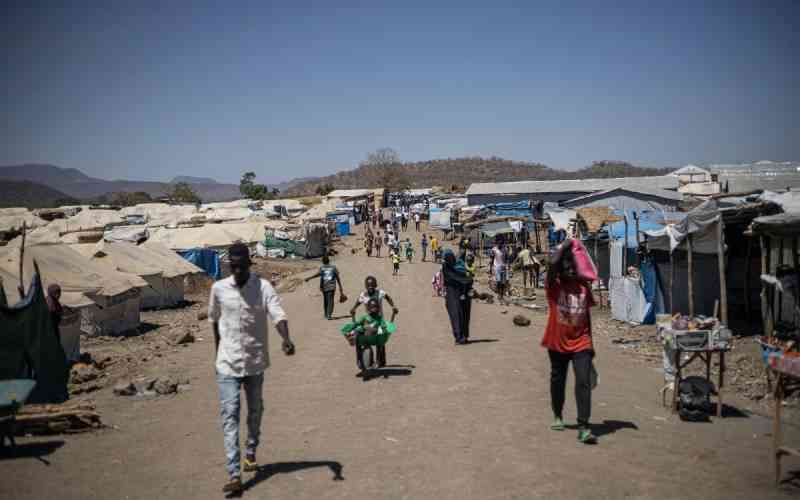Kisumu, Kenya: Mzee John Omollo bemoans helplessly. He once boasted of some ‘prime’ land on the Orongo Beach, but now he can only stare at his five-acres waste away.
Gone with his land is a ‘mysterious’ phenomenon that has left Kanyijowi Village in Osiri Sub-Location, Kisumu West Constituency, abuzz with theories; some scary, others ambitiously optimistic and some bordering on the weird.
More than 100 acre parcel of land belonging to more than 20 families has now been abandoned after the land developed swellings, which have left the land too weak and soggy.
Mzee Omollo recalls how about ten years ago, two cows got stuck in the ground. The shocked residents who had known the area to be a grazing and play field had to pull out the cattle.
“Those of us who came to rescue the cattle discovered that the swelling, which was previously at the lake shore, had expanded to the fields,” says Omollo.
The swelling, which has been witnessed in more than ten spots within the vast field has rendered the parcel useless. Black fluid oozes from small openings and drains downstream to the lake.
Swallow village
The lush field is deceptively appealing to the eye. This is the grass that grew on the raised ground, displacing the normal grass, which villagers were familiar with.
Residents say the swelling has continued to spread upstream eating on the neighbouring fields and paths leading to the beach. They fear that the phenomenon may swallow the entire village, which is adjacent to the beach.
Recently, a resident who was transporting building materials in a lorry had the lorry stuck deep into the soil on a dry day.
According to Omollo, the residents have unsuccessfully sought the attention of the authorities and are contemplating relocating from the area to safer places.
“We do not know what may befall the entire community with this kind of phenomenon, and we need to know what is causing the swelling and the oozing fluid,” he says.
Villagers have been left to rely on their limited wisdom for an explanation: “From narrations about the formation of Lake Simbi, the residents fear this area too, may sink,” says local chief Paul Otieno.
Otieno says the theory has pushed most fishermen to other beaches. The optimists claim the dark fluid could be a sign of oil presence in the underground. This theory has held the residents’ attention with most of them keen to reap from extraction of any mineral, which may come up with the phenomenon.
According to Nyanza Regional Geologist Martin Nyakinye, the area risks volcanic eruption or depression.
Stay informed. Subscribe to our newsletter
Nyakinye says the flabbiness of the ground is as a result of swelling clays, which absorbs a lot of water and increase in volume.
“Since the clay is surrounded by a hard pan, which does not allow the flow of the clay downstream, the ground becomes weak and flabby,” he says.
Extensive study
Even though no major tragedy has been reported, Nyakinye says the continued flow of the mud clay may at one point lead to eruption or depression.
Nyakinye advises that the area be fenced to avoid accidents and geologists be deployed to carry out extensive study of the extent of the land affected and future prospects so as to give necessary information to the villagers.
“Our preliminary studies indicate that the impacts of the phenomenon are spreading hence, we have proposed faster geophysical examination of the sub-surface to determine the next move,” Nyakinye adds.
According to the geologists, this is the first incident in the country.
A report by Kisumu County Environmental Management, recognises the urgency of a scientific explanation and prevention.
County Environment Chief Officer John Sande, says they have partnered with the National Environment Management Authority and the Ministry of Mining to undertake the study.
“We have warned that the area is dangerous and needs urgent action to avoid more risk to the residents,” Sande says.
The report has indicated that the phenomenon has led to increased salinity of water in the nearby wells, low crop yields, weakening of the ground and could be a disaster in waiting.
Fish ponds, which were located in the area, have since been relocated as the dark fluid seems to have polluted the pond waters leading to massive death of fish.
“We discovered very late that the fluid could have contributed to the poor productivity in our fish ponds, but over five fish ponds and vegetable gardens have all been transferred,” says the chief.
 The Standard Group Plc is a
multi-media organization with investments in media platforms spanning newspaper
print operations, television, radio broadcasting, digital and online services. The
Standard Group is recognized as a leading multi-media house in Kenya with a key
influence in matters of national and international interest.
The Standard Group Plc is a
multi-media organization with investments in media platforms spanning newspaper
print operations, television, radio broadcasting, digital and online services. The
Standard Group is recognized as a leading multi-media house in Kenya with a key
influence in matters of national and international interest.
 The Standard Group Plc is a
multi-media organization with investments in media platforms spanning newspaper
print operations, television, radio broadcasting, digital and online services. The
Standard Group is recognized as a leading multi-media house in Kenya with a key
influence in matters of national and international interest.
The Standard Group Plc is a
multi-media organization with investments in media platforms spanning newspaper
print operations, television, radio broadcasting, digital and online services. The
Standard Group is recognized as a leading multi-media house in Kenya with a key
influence in matters of national and international interest.







